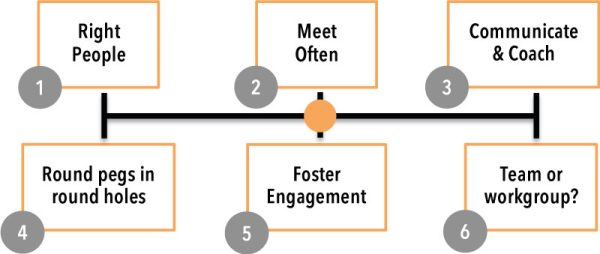You have a team because more gets done than if you do it yourself. The pitfall is … that if you don’t build your team and lead them effectively, you spend more time troubleshooting than succeeding.

Here are the 6 simple success steps: miss one out and it will cause you pain.

Get the right people on the bus: having the right people on your bus and getting the wrong folks off the bus is the critical first step. Your people want to go where you are going, and are happy following you: they are motivated; the wrong people are not.
Meet often: it’s very simple; if you want to influence people, you have to talk to them. If you have day-to-day responsibility [as opposed to a strategic overview, say] and direct reports, then there are 3 levels of ‘meet’, daily, weekly and monthly. This might be daily brief contact [heads up], weekly update or briefing and at least monthly a 30 minute 1-2-1 session. Or it might work better to have daily heads up, fortnightly 121 and monthly team meeting. You have to be rigorous: daily stuff is informal and can be on the phone. the weekly and monthly meetings take absolute priority, because they are your route of influence. In case of crisis, rebook them, very soon.
Communicate & Coach: maybe they should, but real people don’t know what you want by osmosis. Good Leaders make their expectations [required outcomes] explicit but leave process to the individual: and they explain the big picture. Workers need to know what they are doing right [encouragement works better than chastisement] and they have short memories. Research shows you must ‘find them doing something well’ at least once weekly. Coach problems in the 121 to support the change that you need. [Email nick@gholdenphish.com for a free 121 meeting and Next Step Coaching template ].
Round pegs etc: beyond organisational fit, you get more out of people if there is good job fit. This means people doing what they do well, every day. You may be intuitive, but profiling is more effective [email as above to arrange profiling of difficult people or to see the gaps in your team]. There is no point expecting someone who hates figures to compile the daily sales spreadsheet.
Engagement: Part 2 of this series talked about motivation. Engagement is the measure of how motivated each person is. [We can measure this].
Team or workgroup? It helps to distinguish if you have a workgroup of people doing diverse things or a team of people all working on the one goal, albeit with different tasks to do, individually [pilot, cabin crew, mechanic, baggage handler]. If it really is a team then they all need to know the goal and your expectations of their role. More good stuff happens if you have well-organised and short team meetings.
At Gholdenphish, we love helping Leaders build & lead teams, and teams outperform their previous form,




Comments are closed.